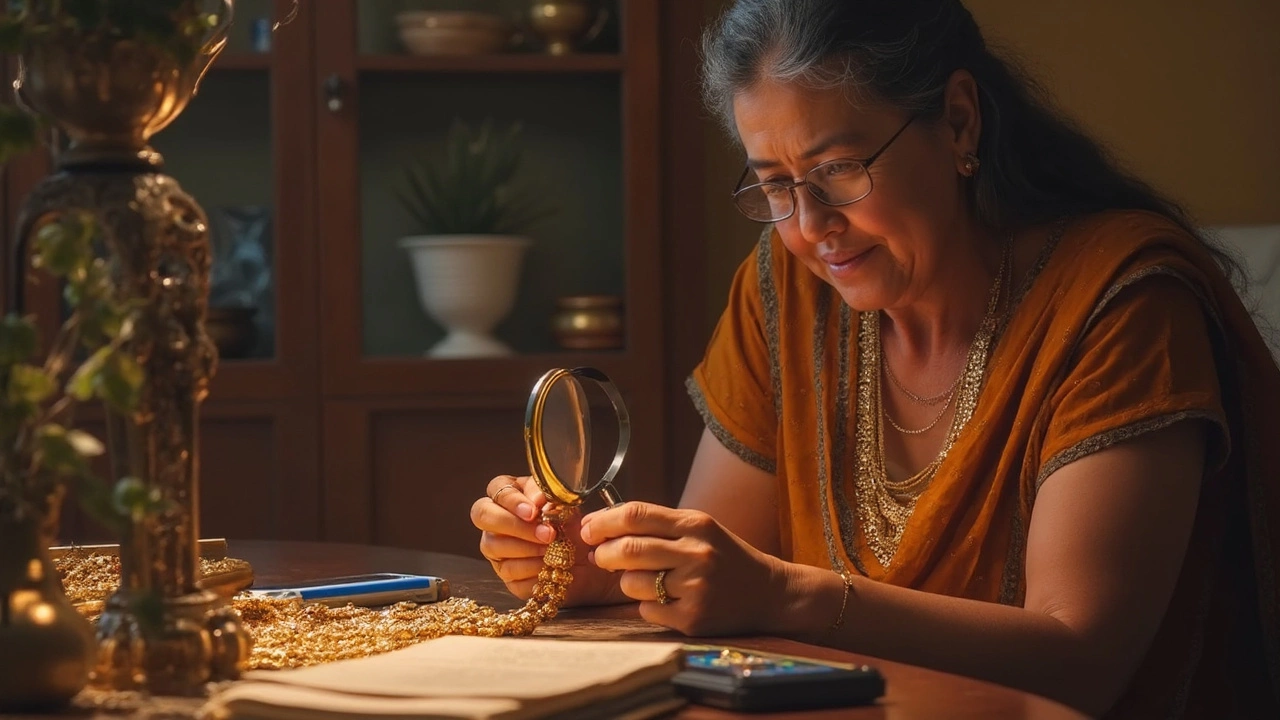If you've ever held a piece of old jewelry and wondered, 'Is this actually valuable or just sentimental?', you're not alone. So many people have a vintage ring or necklace tucked away, unsure if it's treasure or just a keepsake. The first step: take a good look—literally. Your eyes, a regular magnifying glass, and a little patience are all you really need to start.
Check for any stamps or marks. These tiny engravings, often hiding on clasps or inside ring bands, usually tell you the metal type and sometimes even the maker. See a '14K'? That's solid gold. A squiggle or initials? Could be a famous design house, but might also just be an old family jeweler. Google's your friend for looking these up, but be ready—there are loads of copycats and confusing marks out there.
If you spot loose stones or unique designs, don't assume they're worthless. Old glass can mimic precious stones surprisingly well, and certain quirky settings actually boost a piece's value if they're true to a specific era. Take clear photos from different angles. Having pictures ready will help if you decide to get a second opinion or try an online appraisal service.
- Spotting Antique Jewelry: First Clues
- Photos, Marks, and Materials: What to Look For
- Understanding Fashion vs Real Value
- Getting a Professional Appraisal
- Avoiding Common Valuation Mistakes
- Tips for Selling or Insuring Your Pieces
Spotting Antique Jewelry: First Clues
The hunt for real older pieces starts before you even leave your house. Some easy checks can help you separate everyday trinkets from genuine antique jewelry that could actually be worth something.
First, pay attention to wear and patina. Older jewelry often has a certain look to it: the metal may show faded spots or soft edges from decades of use, while a super shiny finish usually means it's much newer. But don't worry if something looks dull—a natural patina can be a really good sign.
Next, try a basic magnet test on anything gold or silver. Pure gold or sterling silver won’t stick to a magnet, but lots of fakes will. It’s dead simple and takes ten seconds. Just don’t rely on this alone—some antiques contain other metals inside for strength, so it’s only one clue.
Look out for construction styles. Antique pieces were often hand-made, so you might spot tiny tool marks or see things aren't perfectly symmetrical. Clasp styles can give away the age, too. For example, a 'C' clasp on a brooch points to Victorian-era jewelry, while screw-back earrings are from the early 1900s, before pierced ears got popular again.
Check for old-fashioned gemstones. Back before modern gem-cutting, stones had chunkier cuts and less-perfect symmetry—think rose-cut diamonds or irregular pearls. Paste (glass) stones set in silver are another flag, especially for pieces from the 1700s and 1800s. Vintage packaging or boxes can add even more proof, so save them if you have them.
- Wear and patina: Look for soft, smooth spots from age.
- Magnet test: Non-magnetic means it’s likely real gold or silver.
- Hand-made quirks: Slight asymmetry or tool marks are good signs.
- Clasp and fastener style: Certain types only existed in specific eras.
- Stone cuts: Chunky, irregular cuts point to older pieces.
If you check a few of these details and something feels off, play detective. Snap a few pics and do quick searches for lookalikes online, or even ask in collector forums. The more signs you spot, the easier it gets to tell if your granny's brooch might be an actual antique worth digging into.
Photos, Marks, and Materials: What to Look For
This is where things get real. Before you hand over your jewelry or start Googling like mad, you need solid info about your piece. Taking clear, close-up photos is a must. Front, back, sides—get every angle. Zoom in especially on any engraving, stamp, or odd feature. If you post online for help, good photos make all the difference. Bad photos lead to bad guesses.
Now, let’s talk about those mysterious marks. Known as hallmarks or maker’s marks, they’re basically jewelry birth certificates. Here’s what you want to look for:
- Metal stamps: 18K, 14K, 10K for gold (the higher, the purer), 925 for sterling silver, and 'PLAT' or '950' for platinum.
- Maker’s mark: This is a symbol or initials. Some antique jewelry was made by big names like Tiffany & Co. or Cartier—finding those can skyrocket the value.
- Country mark: French jewelry, especially pre-1950, often has an eagle or boar’s head for gold. British pieces might use lions, crowns, or leopard heads.
If your piece doesn’t have a clear mark, don’t panic. Back in the 1800s, lots of small-batch designers skipped stamps completely. In that case, the material and how it’s put together matter a lot.
To figure out what you’ve got, gently test its weight and look for telltale signs:
- If it feels surprisingly heavy for its size, it might be solid gold or platinum.
- Tarnish is usually a sign of lower-value metal (like brass or copper) but real antique jewelry can show some discoloration from age even if it’s precious metal.
- Hold a magnet to your jewelry. Pure gold, silver, and platinum aren’t magnetic—but watch out, some clasps have steel springs, so test those separately.
Here’s a quick stats table that can help when you’re checking marks:
| Mark | Material | What It Means |
|---|---|---|
| 18K | Gold | 75% pure gold |
| 925 | Silver | Sterling silver (92.5% pure) |
| 950 | Platinum | 95% pure platinum |
| Cartier, Tiffany & Co. | Maker’s Mark | Designer, potentially high value |
If still stumped, look at the style. Certain designs, like Art Deco (geometric, 1920s) or Victorian (lots of filigree, mid-1800s) scream their age and can nudge value up or down. Put everything you find into a little notebook—when you talk to an appraiser or check price guides, details are your best friend.
Understanding Fashion vs Real Value
It's easy to get tricked by flashy trends, especially when it comes to jewelry worth. But just because a piece is stylish right now doesn’t mean it’s actually valuable in the real world. Fashion changes fast, but genuine value in antique jewelry sticks around for much longer and is based on more solid ground—materials, age, craftsmanship, and rarity.
Let’s break down what really matters. For starters, the value of many vintage pieces comes from their precious metals and stones. Pure gold, platinum, and real gemstones are what buyers and appraisers look for. If your jewelry is gold plated, even if it looks stunning, it won’t fetch as much as solid gold items, no matter what runway trends say. This is huge if you inherited a piece from the 1960s—it might look groovy, but check what it’s made of before getting too excited.
The maker and time period matter a lot. Big-name designers and genuine eras like Art Deco (1920s-1930s) or Victorian (late 1800s) tend to raise prices. A true Cartier brooch from the 1920s is in a different league from a mass-made vintage piece with a similar look. If unique techniques like hand engraving or specific old cuts of gemstones (think "old mine cut" or "rose cut" diamonds) are present, that’s another sign you’ve got something with real value.
Here’s a quick table so you see how fashion value and real value can play out in numbers:
| Type | Fashion Value | Real Value |
|---|---|---|
| Gold-Plated Chunky Necklace (2020s style) | $50 - $120 | $10 (base metal scrap) |
| Victorian-Era Gold Brooch (Solid 14K) | $200 - $300 | $800 - $2,000 |
| Art Deco Platinum Ring, Real Diamonds | $1,000 | $3,000 - $10,000+ |
| Faux Pearl Necklace (Popular in 1960s) | $40 | $5 - $10 |
Always remember: buyers and collectors pay big for authenticity, not just looks. That’s why old costume jewelry, no matter how cool it looks, usually won’t match the price of genuine antique pieces—even if it’s all over Instagram right now.
- Check if your jewelry is real gold, platinum, or has genuine precious stones.
- Research the maker and era. Don’t get fooled by retro style alone.
- Use appraisal reports or seller receipts if available—they help prove value.
The bottom line? If you care about dollars, focus on what’s inside and where it came from—not just how it catches the light.

Getting a Professional Appraisal
So you’ve checked for stamps and searched online, but you’re still unsure what your jewelry is really worth. That’s when it’s time to get a professional opinion. Not all appraisers are equal, so finding the right expert can make a big difference.
Start by looking for appraisers who are certified by groups like the Gemological Institute of America (GIA) or the American Society of Appraisers (ASA). Certified pros know how to spot fakes, understand historical value, and can give you an official document stating what your piece is actually worth. If someone promises you sky-high prices without really inspecting your piece, walk away. Real professionals work face-to-face, use proper tools—think loupes and gem testers—and talk you through their process.
Here’s what a typical appraisal process looks like:
- Book an appointment and bring all paperwork or history you have about your item. Provenance and previous appraisals help a lot.
- The appraiser inspects the piece under magnification, weighs it, checks for gold or silver content, and tests any gems.
- They research similar pieces sold at auction or through dealers, especially for antique jewelry because market trends change.
- You get a written report telling you the likely market value, usually for insurance or resale purposes.
Don’t be shy to ask how the appraiser charges—some go by item, others by the hour. Always ask for a written estimate before you agree. If your jewelry looks valuable, consider a second opinion, especially if it’s for something big like selling or dividing an estate.
One last tip: don’t clean or repair your item before the appraisal. Sometimes, a quick scrub can damage the original finish or patina, which can actually reduce value. Certified appraisers see thousands of pieces—chances are, they’ve seen something just like yours and can tell you exactly what you’ve got.
Avoiding Common Valuation Mistakes
A lot of people slip up when trying to figure out their jewelry worth. It’s easy to make these mistakes, especially if you go with your gut or grab a number you saw in an auction listing. But guessing wrong means you could lose out—either by underselling or paying too much for insurance.
One classic mistake? Assuming all marks mean real gold or that every old stone is a diamond. Just because a ring says “18K” doesn’t guarantee it’s solid gold—fake stamps are a thing, especially on post-1980s pieces. Good jewelers test the metal, often using acid or an XRF gun (that’s a real tool, and it gives super-quick readings on metal content).
Another misstep is trusting family lore over actual facts. That “priceless” brooch from Aunt Rita might be more costume than crown jewels. Stories help, but they don’t set value. Get an unbiased eye on it, preferably someone who doesn’t want to buy it from you—conflicts of interest come up a lot more often than you’d think.
Here are some common blunders to watch for:
- Skipping the research on maker’s marks.
- Ignoring damage (chips, broken clasps, replaced stones all drop value).
- Assuming appraisals for insurance = actual market value (insurance values are almost always higher—sometimes double what you could sell for).
- Letting TV shows or viral posts set your expectations (those show high-end auctions, not the average antique shop!).
- Not checking comparable sales on reputable auction sites or shops.
It helps to know that actual selling prices almost always differ from the sticker prices you see online. Here’s a simple breakdown to show the gap:
| Source | Average Appraisal Value | Typical Sale Price |
|---|---|---|
| Insurance appraisal | $5,000 | $2,500 |
| Online jewelry shop | $3,000 | $1,800 |
| Auction (in-person) | $2,500 | $1,200 |
If you want to avoid overvaluing your items or being taken for a ride, stick to double-checking facts, asking different experts, and looking at completed sales instead of just "for sale" prices. Never hesitate to dig a little deeper; a fifteen-minute search can save (or earn) you serious cash.
Tips for Selling or Insuring Your Pieces
So, you've figured out what your jewelry might be worth and are thinking about selling it, insuring it, or both. Getting the best deal—and making sure you’re properly covered—boils down to a few practical steps.
First off, always get a written appraisal from a certified appraiser before selling or insuring. You want the appraiser to have credentials from places like the Gemological Institute of America (GIA) or the American Society of Appraisers. This isn’t just about peace of mind. Insurance companies and serious buyers trust these credits, so it can actually boost what you get paid or what coverage you receive.
When it comes to selling, skip the pawn shops if you can. They’re usually a last resort—most pay only a fraction of what your stuff is worth. Instead, look for reputable antique jewelry dealers or try auction houses that specialize in vintage pieces. Many people use online platforms like Etsy or eBay, but the key is clear photos, detailed descriptions, and proof that your items are legit. If you’re not in a rush, consignment with a trusted shop can sometimes get you top dollar, though you’ll have to wait for your cash.
Here are some steps to keep things smooth:
- Keep every document you get: appraisals, sales receipts, certificates, and clear photos. This paperwork really matters at insurance time or if buyers have questions.
- Compare offers. Don’t jump at the first one. Three or more quotes can save you a ton of regret.
- For insurance, let your provider see the latest appraisal. Ask if specialized jewelry coverage is smarter than basic homeowner's insurance (it often is, especially for rare or antique jewelry).
- If a buyer tries to rush or lowball you, that's a red flag. Smart buyers want genuine info and will respect your process.
Speaking of insurance, not all policies are created equal. Most basic policies cover theft or disasters, but many put a cap on payouts. Some companies offer 'full value' or 'agreed value' policies that use your most recent appraisal. Double-check details—will you need reappraisals if the market changes? How do claims work if a piece gets lost or damaged?
Here’s how some payouts usually shake out (rough averages):
| Item | Payout (Private Sale) | Payout (Dealer) | Payout (Pawn Shop) |
|---|---|---|---|
| Antique Gold Ring (14K) | 70-90% of appraised value | 55-75% of appraised value | 25-35% of appraised value |
| Art Deco Diamond Brooch | 80-95% of appraised value | 60-80% of appraised value | 25-35% of appraised value |
One last thing—stay organized, especially if you own more than one piece. Make a file (even if it’s just on your phone) with pictures, appraisals, and current values for each item. It’ll save you headaches if you’re ever in a position to sell, insure, or even just brag a little. In the world of jewelry worth, proof and patience pay off.



